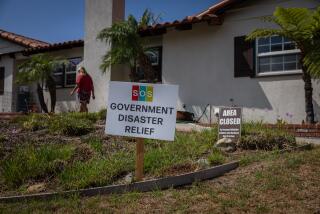Laguna Slide Is ‘a Solvable Problem,’ Says a Survivor
On a cool October morning in 1978, Dale Ghere awoke to popping sounds, as if big raindrops were splashing on the roof.
But when he went outside to bring in the patio furniture to keep it from getting wet, it wasn’t raining. He looked up the street and saw that it had fractured, leaving an 8-inch break in the roadway.
Forty minutes later, Ghere’s home had slid 50 feet. When he returned to Meadowlark Lane after the ground had settled, he found wide gaps separating the floors from the walls of his house, and large cracks crisscrossing his driveway. It would be three years before he, his wife and two children moved back in.
In all, 24 homes in Bluebird Canyon were destroyed in the landslide, casting the lives and fortunes of such hillside residents as Ghere into uncertainty.
Ghere considered giving up and moving to flat ground. He tried to buy another home in Laguna, but because he was living on a teacher’s salary and still paying off a house that no longer existed, loan officers looked at him incredulously.
“Financially, my only option was to build back,” he said.
Federal emergency funds helped with the rent for one year while Ghere, as president of the Bluebird Knolls Community Assn., helped negotiate moratoriums on slide victims’ loan payments with local mortgage firms.
Homes were slated for demolition, so association members salvaged everything they could. They took doors, countertops, bathtubs and washers -- and even dug up plants. They raised $21,000 at a community garage sale.
Like most residents who chose to rebuild, Ghere got low-interest federal loans and built as much of the house as he could himself. It took him three years and $70,000 to build the two-story, wood-frame structure.
Over time, all 24 homes went back up. Nearly two weeks ago, it happened again, this time sparing Ghere’s house. Ghere noticed that the water pressure at his house was unusually low and saw that the power had gone out. He walked outside and turned toward nearby Oriole Drive in time to see a house slide. Ghere took off running and roused the neighborhood.
“I was right back in 1978, banging on doors, yelling, trying to get people down the hill,” he said. “I just wasn’t running as fast.”
In the following days, Ghere offered his help and contacts to slide victims, finding a local church that would let residents meet and organize.
Seated in a rocking chair in his living room on a recent afternoon, Ghere, 64, said it was important for the rest of the community that the hillside was fixed.
“If they decide not to help, it sends a terrible message to the rest of the community. What about the next time there’s a flood or a fire?” he said. “It’s a solvable problem. Look at this hill.”
Ghere walked to the coffee table where there were half a dozen large photographs, some taken days after the old slide and some at different stages of restoration.
He picked up one that showed the hillside being regraded. Workers had done such a thorough job of restoring the hill that it was hard even for him to tell where the old slide began and ended.
There have been hurricanes and tornadoes across the country, he said. “I don’t think we want to get to a point where we say, ‘This time, we’re not going to help anybody,’ ” he said. “We have a history in America of helping those in need.”
More to Read
Sign up for Essential California
The most important California stories and recommendations in your inbox every morning.
You may occasionally receive promotional content from the Los Angeles Times.









